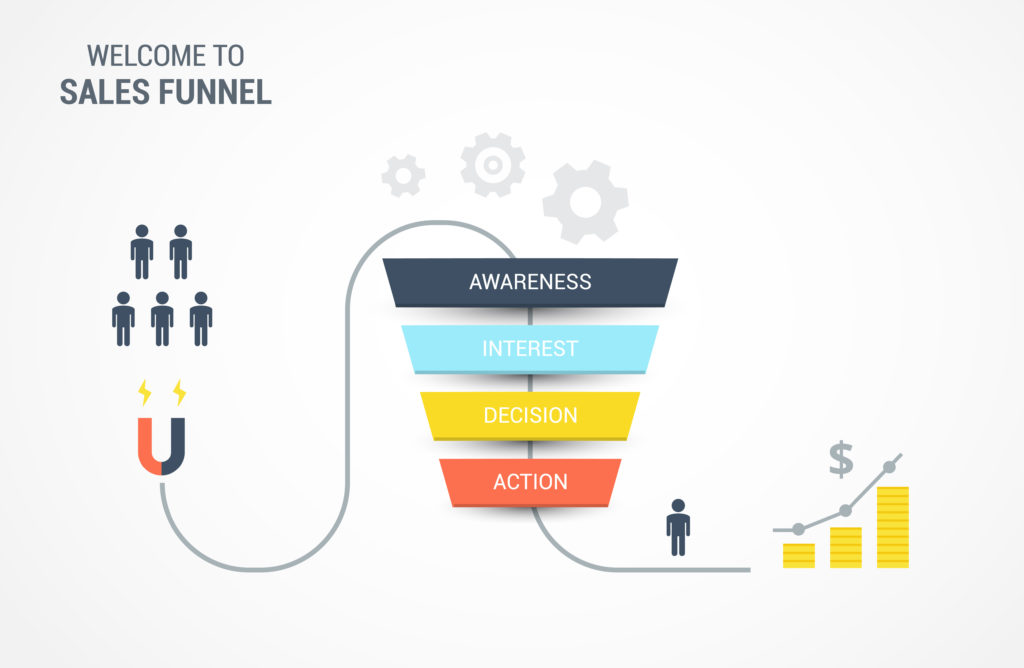Nov. 7, 2018

Light at the End of the Funnel – The Sales Funnel
What is the sales funnel? The process that every lead must go through before being transformed into a customer with your business. For the customer, the sales funnel may be fun and exciting. They get a good look at a number of amazing products, they get personalized attention from a range of stores, and they’re eager to learn more about how a specific product can help them meet their goals. For the salesperson, however, the sales funnel may seem endless.
Most of us in sales are ‘A’ type apex predators. The thrill of the hunt and sale keeps us up and fuels us! Is the customer ever going to make a decision? When they disappear, are they thinking things over, or are they gone for good? It’s a long, often frustrating process (Can’t they just make a decision already?) that may leave you wondering how you’re supposed to nurture your leads through the entire process— especially in today’s digital society, where most customers take care of their own journey through the sales funnel instead of connecting regularly with salespeople along the way.
There is, however, light at the end of the funnel! In most cases, it takes a minimum of seven visits to turn leads into sales. By sticking to it, however, you can see that light and make the sales you’re hoping for.
What is the Sales Funnel?

What is the sales funnel journey that buyers must take before they make a decision to purchase a product or service from your store? It contains four key stages that are shaped both by the state where the buyer currently is in their buying decisions and the information that they’re looking for in the middle of that state: the awareness stage, the interest stage, the decision phase, and the action phase, known as AIDA. By understanding these four key stages of the sales funnel, it’s possible to create specialized content geared toward each of these stages that will help influence buyer decisions and make them more likely to choose your product over your competitors’—particularly if you stick with your customers through the process and provide them with the information they need.
1. The Awareness Stage
During the awareness stage, customers are just entering the sales funnel. They’ve become aware of your product and, hopefully, they’re becoming aware of your business. This is where SEO, your social media marketing plan, and general advertising are critical: you’re making customers aware of the products or services you offer and how they can solve customers’ pain points. Making customers aware of your business—as opposed to your competitors’ businesses—is no easy feat! Even though this is the largest stage of the funnel, it’s also one of the hardest to capture effectively. There are several strategies to keep in mind during the awareness stage of the funnel.
- Learn how to evaluate the quality of your leads early in the sales funnel. Some customers are genuinely interested in your products and may need a quick solution for their problems, while others are just browsing. When you make this evaluation quickly, you can decrease time spent on leads who aren’t going to purchase these items at this time, freeing your time to spend more energy on customers who are likely to make a purchase.
- The awareness stage is all about keeping your name and your products out there! Create high-quality content that will encourage browsing throughout your site. Bring customers to your site through search engines, social media, and more.
- Building authority matters during the awareness stage. While paid ads are a great way to bring customers in to take a look at your business, they may also change the way they approach you. Organic search results, on the other hand, let customers know that you’re an authority in your field as they choose to move forward with your business.
2. The Interest Stage
They’re aware of the products and services you offer. Now, customers are getting interested. They’re evaluating your business, learning more about your products, and discovering what sets you apart from your competitors. Chances are, prospects in the interest stage are still considering your competitors, too—and that’s all right! You can provide your customers with high-quality content and information that will help them move through the interest stage and discover whether or not your products are the right fit for them. During the interest stage, there are several key things to keep in mind.
- If you haven’t already, make sure you capture customer information so that you can interact with them directly. Personalized emails tailored to their interests and their stage of the sales funnel can help move customers through the process as well as keeping their interest.
- Develop your sales story to help shape the way customers interact with your business. Decide how you want to present yourself and how that will change the way customers interact with you, then design the content that will help them make decisions about your company.
- Make sure you’re providing high-quality content at this stage! Keep customers interested and interacting. Establish yourself as an authority in your field and let them know that you have the ability to answer their pain points.
3. The Decision Stage
Customers take several contacts with your business—through social media, through email, through your website—before they’re able to reach the critical decision stage of the process. At this point, they’re narrowing things down. They may be looking between a couple of different products that both have the potential to solve their problems, or they may be considering the difference between your products and your competitors’. At the decision stage, you’ll need to start providing content that will let customers know the specifics of your offers. This may include pricing information, reviews from prior customers, or even a product sample or trial that will allow them to more easily make a decision. Capturing customers during the decision phase, rather than allowing them to move away, is critical. During this stage, if your competitors talk your leads around first, customers may disappear without further contact. Encouraging a sense of scarcity—providing a limited-time offer; offering customers a “preview” that might not stick around—can help encourage your leads to make a faster decision.
4. The Action Stage
They’ve made a decision. Now, your leads are ready to take action—and in today’s fast-paced digital market, they may have done it without ever making contact with a salesperson through your business. At this stage, you want to provide your customers with information that will encourage them to make a fast decision in favor of your business. Why should they take action now? What sets your business apart—or makes your products so valuable that your leads should make an immediate decision? Special offers can also be a great choice for this stage of the sales funnel.
By providing high-quality content at every stage of the funnel, from emails and social media posts to your blog content, you can create a more effective marketing strategy that will make it easier to connect with your customers.
Working through the sales funnel is a critical part of maintaining your leads and convincing them to stick with your business. By providing high-quality content at every stage of the funnel, from emails and social media posts to your blog content, you can create a more effective marketing strategy that will make it easier to connect with your customers. Need more information about the sales funnel? Contact us today to learn more about how we can help you transform more of your leads into customers, sticking with them through the long sales funnel until they—and you—reach the light at the other end.
Book with us
Let’s accomplish what you are looking for, our team of experts are here for you.
Let's work togetherWarning: Working with our team may result in excessive creativity, uncontrollable 'aha' moments, and an addiction to perfect pixels. Please proceed with caution.



